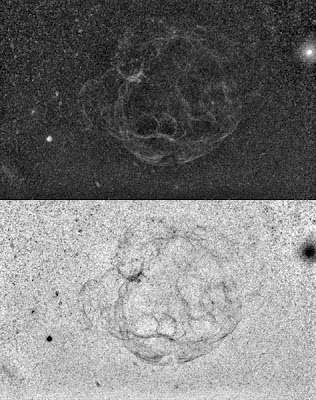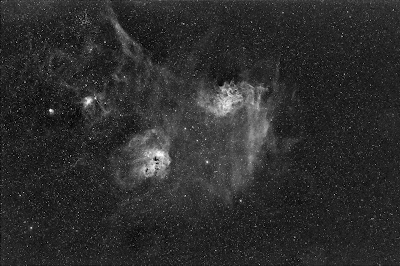COPYRIGHT, PLEASE NOTE
All the material on this website is copyrighted to J-P Metsavainio, if not otherwise stated. Any content on this website may not be reproduced without the author’s permission.
BUY A MUSEUM QUALITY POSTER
BUY A POSTER:https://astroanarchy.zenfolio.com/
Thursday, March 6, 2008
Sh2-240 (Simeis 147)

this is a start of the long project.
my goal is to capture enough photons from this dim object to
be able to reveal its beauty.
This is a supernova remant in Taurus & Auriga.
The angular diameter of the object is huge, about 200'x180'!
Thats about 8 full Moon diameters. Doe the large size
the surfage brightness is very low, I think, I'll need least
20 hours of exposures to capture this well.
Last night I had problems with frost and I was not able to see
it before image processing. All the frames are practically useless.
You can see big bloated stars, even in small image.
How ever, I put small image here just for example.
There is both normal H-alpha image and inverted one.
exposures ( with frost in optics)
4 x 2700 s
3 x 900 s
FD 200mm f2.8 lens, QHY8, guiding QHY5 and LX200 GPS 12"
(This large object and the 200mm lens are very good match.)
Labels:
Canon FD 200mm f2.8 images,
nebula
Friday, February 29, 2008
Litle test, jus for fun

This is a sample about 3D-transform.
In the left side image the great galaxy of Andromeda is seen as normally.
On the right side image the same galaxy is twisted,
so that you are able to see it as seen from above.
Original image was not very high quality, but even tough, more
general structure can be seen in this manner.
It looks like the spiral structure is more visible in the right hand image.
I'll like to try this to some high resolution, nearly on edge galaxy, later.
I did this tarnsform under PhotoShop this time. by
using simple tretch.
Better results can be archived with real 3D-software, where I can project the image
to a real 3D-surface and rotate it to an any angle i like.´I'll try that later.
Labels:
research and development
Thursday, February 28, 2008
The Great Globular Cluster in Hercules, M13

M13 image is from 27.02., same night as previous IC 405 & IC 405 image.
Picture is scaled down about 50%
This one was hard to process doe massive light pollution defects,
gradient, LP noise and weak S/N ratio.
Imaging telescope:
LX200 gps 12" @ f6.3
Guiding:
SXV-AO @ 10Hz
Cameras:
QHY8 for imaging
Lodestar for guiding
Filter:
IDAS LP
Exposures:
9 X 900s = 2h 15min.
UPDATE
I did a new version.
This time I skipped two frames doe the bad quality.
Now there is 7x900s.
I also used CCDStack positive Constrain deconvolution,33 iterations.
Images are updated.
Wednesday, February 27, 2008
IC 405 & IC410

Flaming Star nebula and its companion forms a beautiful pair.
Image is quite deep doe the fast 200mm f2.8 lens and three hours of exposures,
there is lots of nebulosity visible around main objects.
I'll shoot color for this later.
This is a emission nebula but in the Flaming Star part there should be
som bluish reflection nebulosity as well, lets see if I'm able to pick it up.
I had a lot of technical problems last night. There is a heater strip in the camera assembly to prevent dewing. In some state I managed to destroy the power plug.
I can tell, it's not a nice job to do soldering at snow with freezing wind and darkness.
After that I dropped some essential parts in the deep snow and did spend an hour to looking for them.
Image info:
Canon FD 200mm f2.8 lens coupled with QHY8 6mb cooled color camera.
7nm H-alpha filter
Exposures 9 x 1200s = 3 hours
Guiding and platform LX200 GPS 12" with QHY5 guider.
Processing in CCDStack and PS.
Subscribe to:
Comments (Atom)









